Influence of Monomer Sequence on the Cyclization Behavior of Poly(acrylonitrile-co-acrylamide)
Abstract
1. Introduction
2. Materials and Methods
3. Results and Discussion
3.1. CopolymerSynthesis
3.2. Thermal Treatment of the Copolymers in the Inert Atmosphere: Cyclization Reaction
3.3. Thermal Treatment of the Copolymers in Air
4. Conclusions
Supplementary Materials
Author Contributions
Funding
Data Availability Statement
Conflicts of Interest
References
- Frank, E.; Hermanutz, F.; Buchmeiser, M.R. Carbon Fibers: Precursors, Manufacturing, and Properties. Macromol. Mater. Eng. 2012, 297, 493–501. [Google Scholar] [CrossRef]
- Frank, E.; Steudle, L.M.; Ingildeev, D.; Spörl, D.-C.J.M.; Buchmeiser, M.R. Carbon Fibers: Precursor Systems, Processing, Structure, and Properties. Angew. Chem. Int. Ed. 2014, 53, 5262–5298. [Google Scholar] [CrossRef]
- Huang, X. Fabrication and Properties of Carbon Fibers. Materials 2009, 2, 2369–2403. [Google Scholar] [CrossRef]
- Kaur, J.; Millington, K.; Smith, S. Producing high-quality precursor polymer and fibers to achieve theoretical strength in carbon fibers: A review. J. Appl. Polym. Sci. 2016, 133, 43963. [Google Scholar] [CrossRef]
- Liu, Y.; Kumar, S. Recent progress in fabrication, structure and properties of carbon fibers. Polym. Rev. 2012, 52, 234–258. [Google Scholar] [CrossRef]
- Hao, J.; Liu, Y.; Lu, C. Effect of acrylonitrile sequence distribution on th thermal stabilization reactions and carbon yields of poly(acrylonitrile-co-methyl acrylate). Polym. Degrad. Stab. 2018, 147, 89–96. [Google Scholar] [CrossRef]
- Morgan, P. (Ed.) Carbon Fibers and Their Composites; Taylor and Francis: New York, NY, USA, 2005; pp. 185–259. [Google Scholar]
- Odian, G. Principles of Polymerization, 4th ed.; Wiley-Interscience: Hoboken, NJ, USA, 2004; pp. 198–506. [Google Scholar]
- Tirell, D.A. Copolymer Composition. In Comprehensive Polymer Science and Supplements; Allen, G., Bevington, J.C., Eds.; Elsevier: Amsterdam, The Netherlands, 1989; Volume 3, pp. 195–206. [Google Scholar]
- Chernikova, E.V.; Mineeva, K.O. Reversible Deactivation Radical Copolymerization: Synthesis of Copolymers with Controlled Unit Sequence. Polym. Sci. Ser. B 2022, 64, 1–25. [Google Scholar] [CrossRef]
- Borisova, O.; Billon, L.; Zaremski, M.; Grassl, B.; Bakaeva, Z.; Lapp, A.; Stepanek, P.; Borisov, O. Synthesis and pH- and salinity-controlled self-assembly of novel amphiphilic block-gradient copolymers of styrene and acrylic acid. Soft Matter. 2012, 8, 7649–7659. [Google Scholar] [CrossRef]
- Kozhunova, E.Y.; Plutalova, A.V.; Chernikova, E.V. RAFT Copolymerization of Vinyl Acetate and Acrylic Acid in the Selective Solvent. Polymers 2022, 14, 555. [Google Scholar] [CrossRef] [PubMed]
- Al-Harthi, M.; Khan, M.J.; Abbasi, S.H.; Soares, J.B.P. Gradient Copolymers by ATRP in Semibatch Reactors: Dynamic Monte Carlo Simulation. Macromol. React. Eng. 2009, 3, 148–159. [Google Scholar] [CrossRef]
- Moskowitz, J.D.; Wiggins, J.S. Semibatch RAFT copolymerization of acrylonitrile and Nisopropylacrylamide: Effect of comonomer distribution on cyclization and thermal stability. Polymer 2016, 84, 311–318. [Google Scholar] [CrossRef]
- Toms, R.V.; Balashov, M.S.; Shaova, A.A.; Gerval’d, A.Y.; Prokopov, N.I.; Plutalova, A.V.; Grebenkina, N.A.; Chernikova, E.V. Copolymers of Acrylonitrile and Acrylic Acid: Effect of Composition and Distribution of Chain Units on the Thermal Behavior of Copolymers. Polym. Sci. Ser. B 2020, 62, 102–115. [Google Scholar] [CrossRef]
- Toms, R.V.; Balashov, M.S.; Gerval’d, A.Y.; Prokopov, N.I.; Plutalova, A.V.; Berkovich, A.K.; Chernikova, E.V. Influence of Synthesis Method on the Properties of Carbon Fiber Precursors Based on Acrylonitrile and Acrylic Acid Copolymers. Polym. Sci. Ser. B 2020, 62, 447–457. [Google Scholar] [CrossRef]
- Bahrami, S.H.; Bajaj, P.; Sen, K. Thermal Behavior of Acrylonitrile Carboxylic Acid Copolymers. J. Appl. Polymer Sci. 2003, 88, 685–698. [Google Scholar] [CrossRef]
- Devasia, R.; Nair, C.P.R.; Sivadasan, P.; Katherine, B.K.; Ninan, K.N. Cyclization reaction in poly(acrylonitrile/itaconic acid) copolymer: An isothermal differential scanning calorimetry kinetic study. J. Appl. Polymer Sci. 2003, 88, 915–920. [Google Scholar] [CrossRef]
- Sivy, G.T.; Coleman, M.M. Fourier transform IR studies of the degradation of polyacrylonitrile copolymers—II: Acrylonitrile/methacrylic acid copolymers. Carbon 1981, 19, 127–131. [Google Scholar] [CrossRef]
- Skvortsov, I.Y.; Chernikova, E.V.; Kulichikhin, V.G.; Varfolomeeva, L.A.; Kuzin, M.S.; Toms, R.V.; Prokopov, N.I. The effect of synthetic procedure of acrylonitrile–acrylic acid copolymers on the rheological properties of solutions and features of fiber spinning. Materials 2020, 13, 3454. [Google Scholar] [CrossRef]
- Skvortsov, I.Y.; Varfolomeeva, L.A.; Kuzin, M.S.; Vashchenko, A.F.; Chernikova, E.V.; Toms, R.V.; Kulichikhin, V.G. Effect of the comonomer addition sequence in the synthesis of an acrylonitrile terpolymer on the solution reology and fiber properties. Mendeleev Commun. 2022, 32, 652–654. [Google Scholar] [CrossRef]
- Coleman, M.M.; Sivy, G.T. Fourier transform ir studies of the degradation of polyacrylonitrile copolymers—I: Introduction and comparative rates of the degradation of three copolymers below 200 °C and under reduced pressure. Carbon 1981, 19, 123–126. [Google Scholar] [CrossRef]
- Sivy, G.T.; Coleman, M.M. Fourier transform IR studies of the degradation of polyacrylonitrile copolymers—IV: Acrylonitrile/acrylamide copolymers. Carbon 1981, 19, 137–139. [Google Scholar] [CrossRef]
- Coleman, M.M.; Sivy, G.T.; Painter, P.C.; Snyder, R.W.; Gordon, B., III. Studies of the degradation of acrylonitrile/acrylamide copolymers as a function of composition and temperature. Carbon 1983, 21, 255–267. [Google Scholar] [CrossRef]
- Sivy, G.T.; Gordon, B., III; Coleman, M.M. Carbon, Studies of the degradation of copolymers of acrylonitrile and acrylamide in air at 200 oC. Speculations of the role of the preoxidation step in carbon fiber formation. Carbon 1983, 21, 573–578. [Google Scholar] [CrossRef]
- Sun, J.; Wang, K.; Wang, J.; Qin, C.; Dai, L. Pre-oxidation nanofibers from acrylonitrile-acrylamide copolymers synthesized by solvent-water polymerization. Adv. Mater. Res. 2011, 175–176, 164–169. [Google Scholar] [CrossRef]
- Cheng, R.; Zhou, Y.; Wang, J.; Cheng, Y.; Ryu, S.; Jin, R. High Char-Yield in AN-AM Copolymer by Acidic Hydrolysis of Homopolyacrylonitrile. Carbon Lett. 2013, 14, 34–39. [Google Scholar] [CrossRef]
- Han, N.; Zhang, X.-X.; Wang, X.-C. Various Comonomers in Acrylonitrile Based Copolymers: Effects on Thermal Behavior. Iran. Polym. J. 2010, 19, 243–253. [Google Scholar]
- Takahashi, A.; Tanaka, H.; Kagawa, I. The Analysis and Solubility of Acrylonitrile-Acrylamide Copolymers. Kogyo Kagaku Zasshi 1967, 70, 988–992. [Google Scholar] [CrossRef]
- Chapiro, A.; Perec-Spitzer, L. Influence des solvants sur la copolymerisation de l’acrylamide avec l’acrylonitrile. Eur. Polym. J. 1975, 11, 59–69. [Google Scholar] [CrossRef]
- Hou, C.; Ying, L.; Wang, C. Determination of monomer apparent reactivity ratios for acrylonitrile-acrylamide copolymerization system. J. Mater. Sci. 2005, 40, 609–612. [Google Scholar] [CrossRef]
- Chernikova, E.V.; Kishilov, S.M.; Plutalova, A.V.; Kostina, Y.V.; Bondarenko, G.N.; Baskakov, A.A.; Il’in, S.O.; Nikolaev, A.Y. Specific Features of the Copolymerization of Acrylonitrile and Acrylamide in the Presence of Low-Molecular-Mass and Polymeric Trithiocarbonates and Properties of the Obtained Copolymers. Polym. Sci. Ser. B 2014, 56, 553–565. [Google Scholar] [CrossRef]
- Maksimov, N.M.; Toms, R.V.; Balashov, M.S.; Gerval’d, A.Y.; Prokopov, N.I.; Plutalova, A.V.; Kuzin, M.S.; Skvortsov, I.Y.; Kulichikhin, V.G.; Chernikova, E.V. Novel Potential Precursor of Carbon Fiber Based on Copolymers of Acrylonitrile, Acrylamide, and Alkyl Acrylates. Polym. Sci. Ser. B 2014, 64, 670–687. [Google Scholar] [CrossRef]
- Skvortsov, I.Y.; Maksimov, N.M.; Kuzin, M.S.; Varfolomeeva, L.A.; Toms, R.V.; Chernikova, E.V.; Kulichikhin, V.G. Ifluence of acryl acrylate nature on rheological properties polyacrylonitrile terpolymers solutions, spinnability and mechanical characteristics of fibers. Materials 2023, 16, 107. [Google Scholar] [CrossRef]
- Chernikova, E.V.; Terpugova, P.S.; Garina, E.S.; Golubev, V.B. Controlled radical polymerization of styrene and n -butyl acrylate mediated by trithiocarbonates. Polym. Sci. Ser. A 2007, 49, 108–119. [Google Scholar] [CrossRef]
- Brandrup, J.; Immergut, E.H.; Grulke, E.A. (Eds.) Polymer Handbook; Wiley: New York, NY, USA, 1999. [Google Scholar]
- Holland-moritz, K.; Siesler, H.W. Infrared Spectroscopy of Polymers. Appl. Spectrosc. Rev. 1976, 11, 1–55. [Google Scholar] [CrossRef]
- Kissinger, H.E. Reaction Kinetics in Differential Thermal Analysis. Anal. Chem. 1957, 29, 1702–1706. [Google Scholar] [CrossRef]
- Collins, G.L.; Thomas, N.W.; Williams, G.E. Kinetic relationships between heat generation and nitrile consumption in the reaction of poly(acrylonitrile) in air at 265 °C. Carbon 1988, 26, 671–679. [Google Scholar] [CrossRef]
- Ouyang, Q.; Cheng, L.; Wang, H.; Li, K. Mechanism and kinetics of the stabilization reactions of itaconic acid-modified polyacrylonitrile. Polym. Degrad. Stab. 2008, 93, 1415–1421. [Google Scholar] [CrossRef]
- Moad, G.; Rizzardo, E. (Eds.) RAFT Polymerization: Methods, Synthesis, Applications; Wiley-VCH: Weinheim, Germany, 2022. [Google Scholar]
- Barner-Kowollik, C. (Ed.) Handbook of RAFT Polymerization; Wiley: Weinheim, Germany, 2008. [Google Scholar]
- Moad, G.; Rizzardo, E.; Thang, S.H. Living Radical Polymerization by the RAFT process–A Third Update. Aust. J. Chem. 2012, 65, 985–1076. [Google Scholar] [CrossRef]
- Moad, G. Mechanism and Kinetics of Dithiobenzoate-Mediated RAFT Polymerization–Status of the Dilemma. Macromol. Chem. Phys. 2014, 215, 9–26. [Google Scholar] [CrossRef]
- Van Doremaele, G.H.J.; German, A.L.; de Vries, N.K.; van der Velden, G.P.M. 1H and 13C NMR investigation of the intramolecular structure of solution and emulsion styrene-methyl acrylate copolymers. Macromolecules 1990, 23, 4206–4215. [Google Scholar] [CrossRef]
- Mukherjee, M.; Chatterjee, S.K.; Brar, A.S. One- and two-dimensional nuclear magnetic resonance studies on the compositional sequence and the microstructure of acrylamide/acrylonitrile copolymers. J. Appl. Polym. Sci. 1999, 73, 55–67. [Google Scholar] [CrossRef]
- Chernikova, E.V.; Sivtsov, E.V. Reversible Addition-Fragmentation Chain-Transfer Polymerization: Fundamentals and Use in Practice. Polym. Sci. Ser. B 2017, 59, 117–146. [Google Scholar] [CrossRef]
- Wu, X.; Zhang, X.; Lu, C.; Ling, L. Thermo-chemical reactions and structural evolution of acrylamide-modified polyacrylonitrile. Chin. J. Polym. Sci. 2010, 28, 367–376. [Google Scholar] [CrossRef]

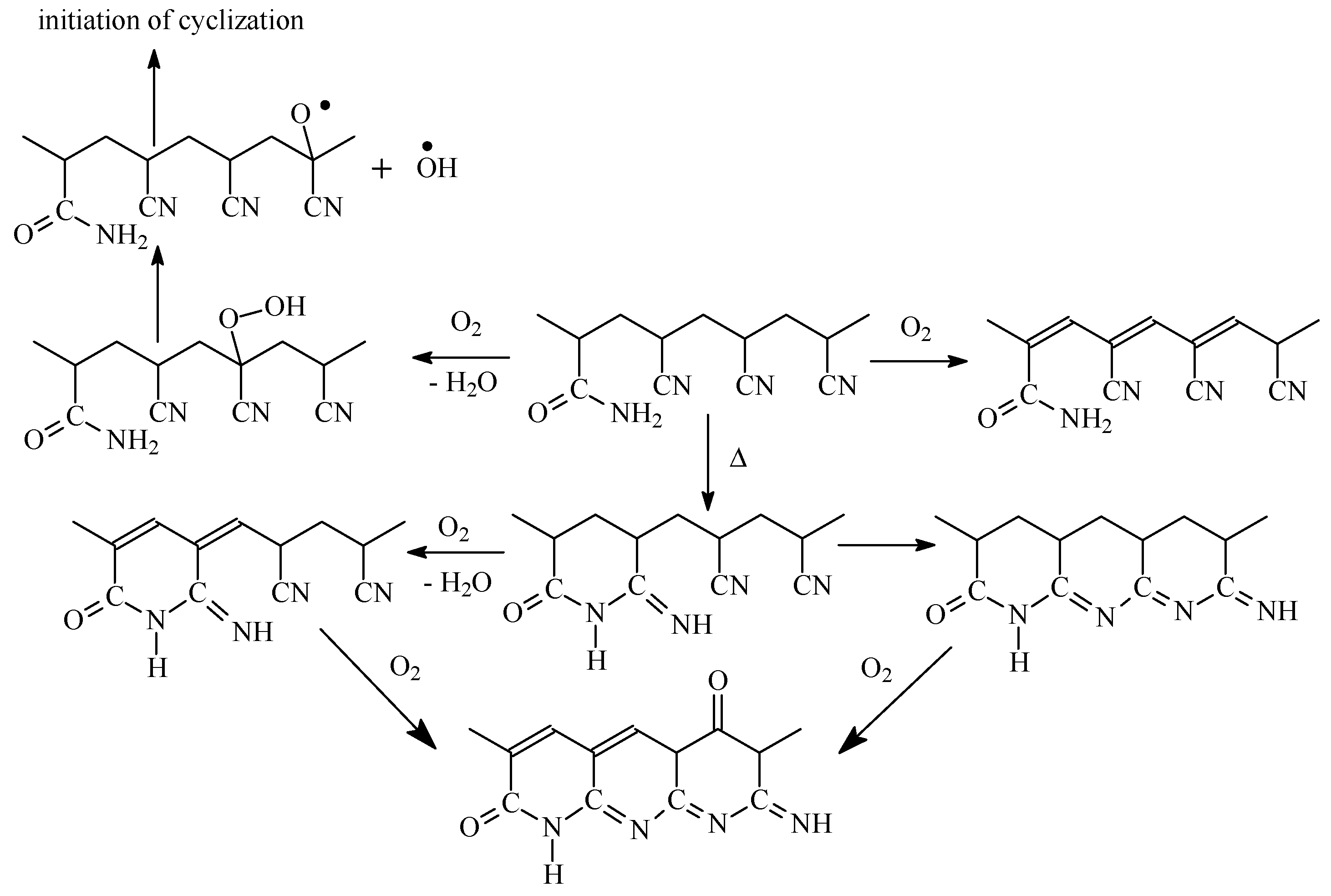
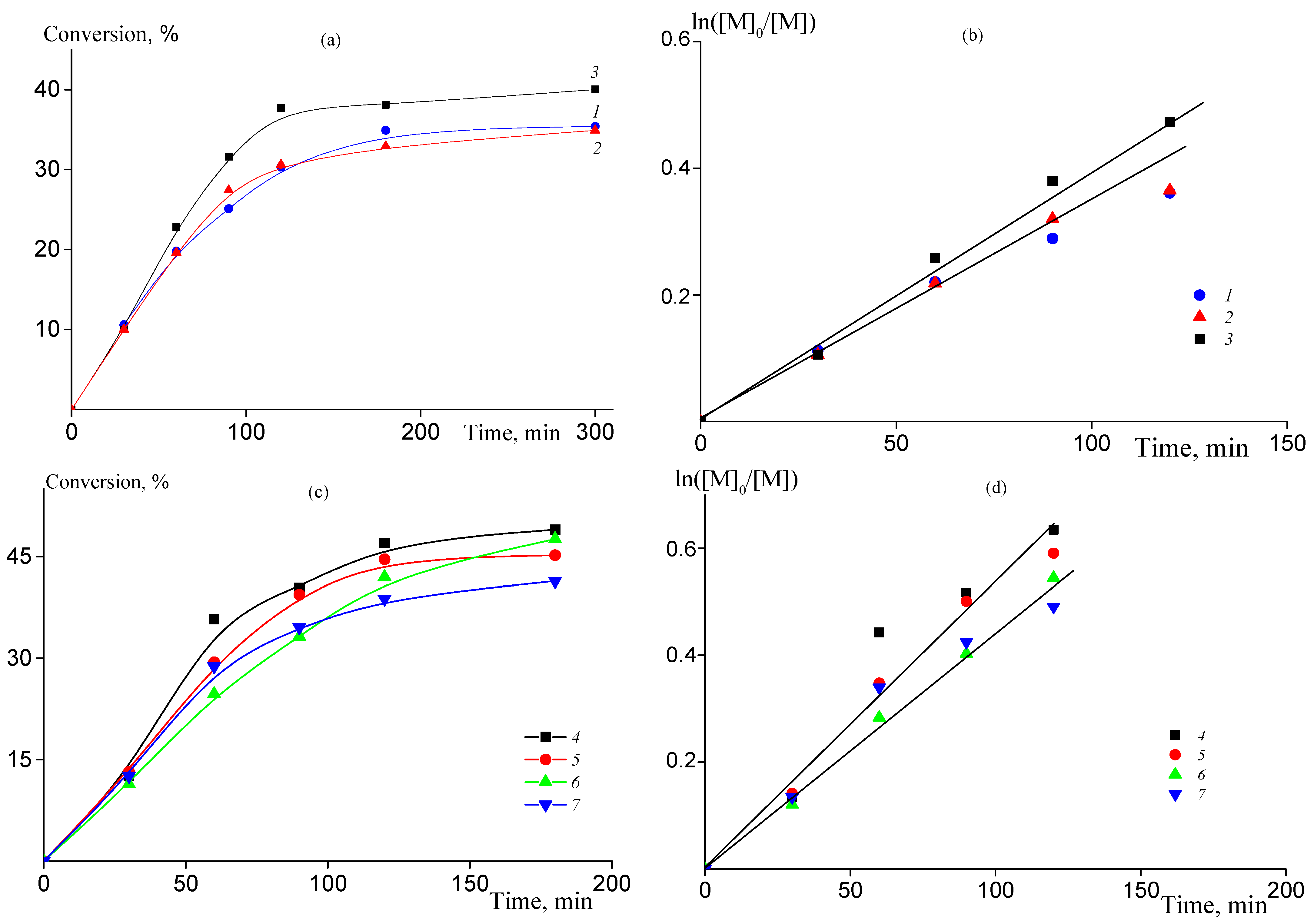

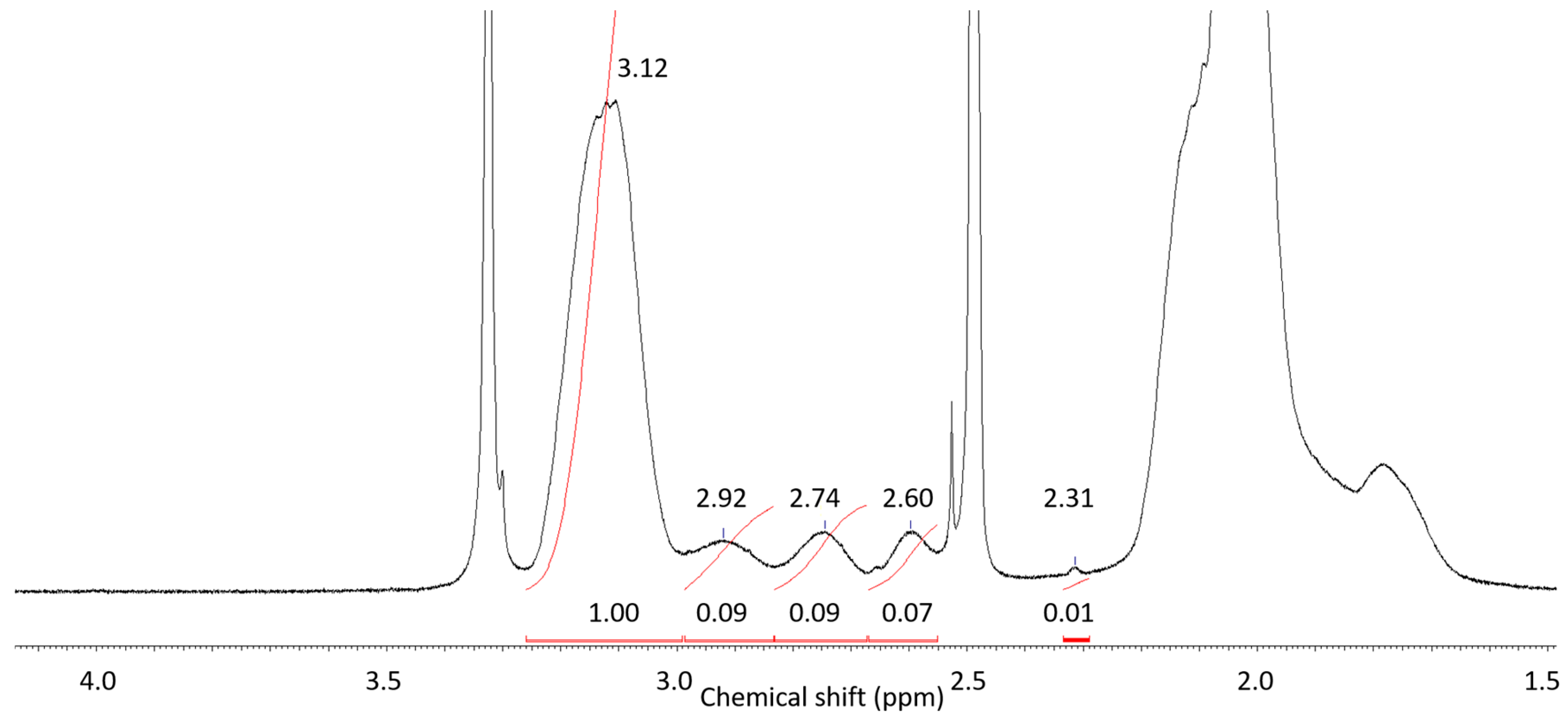
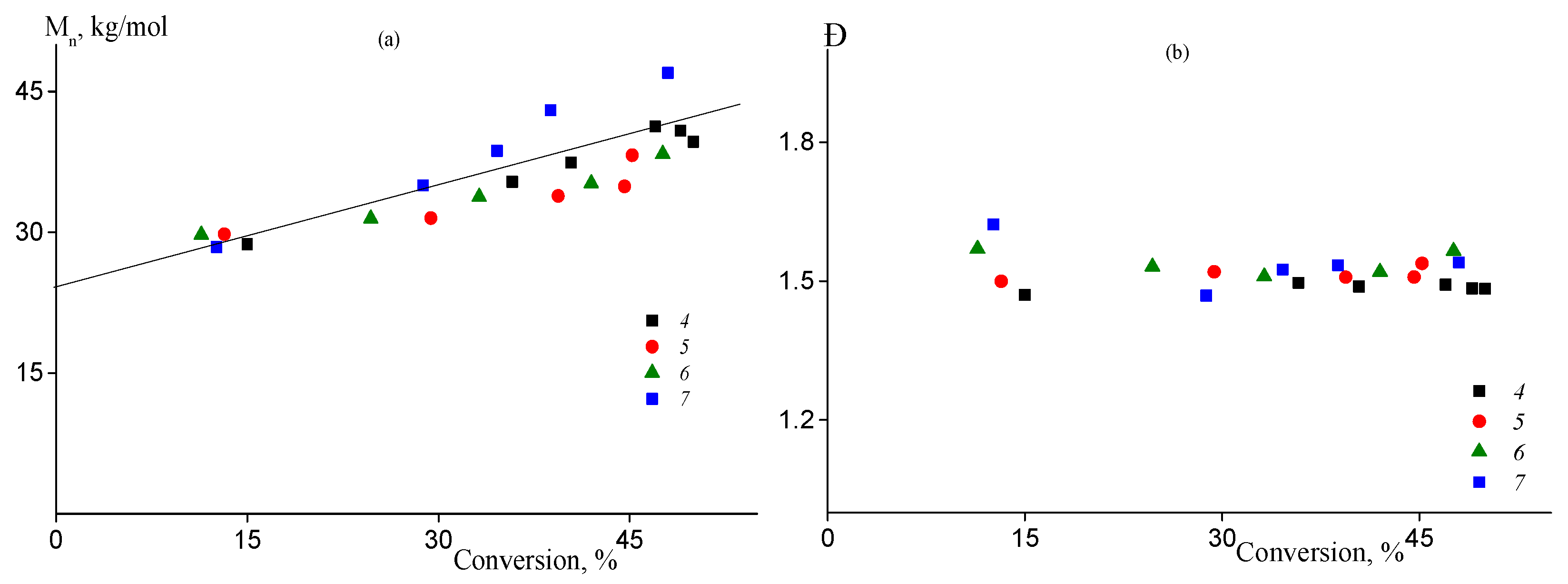
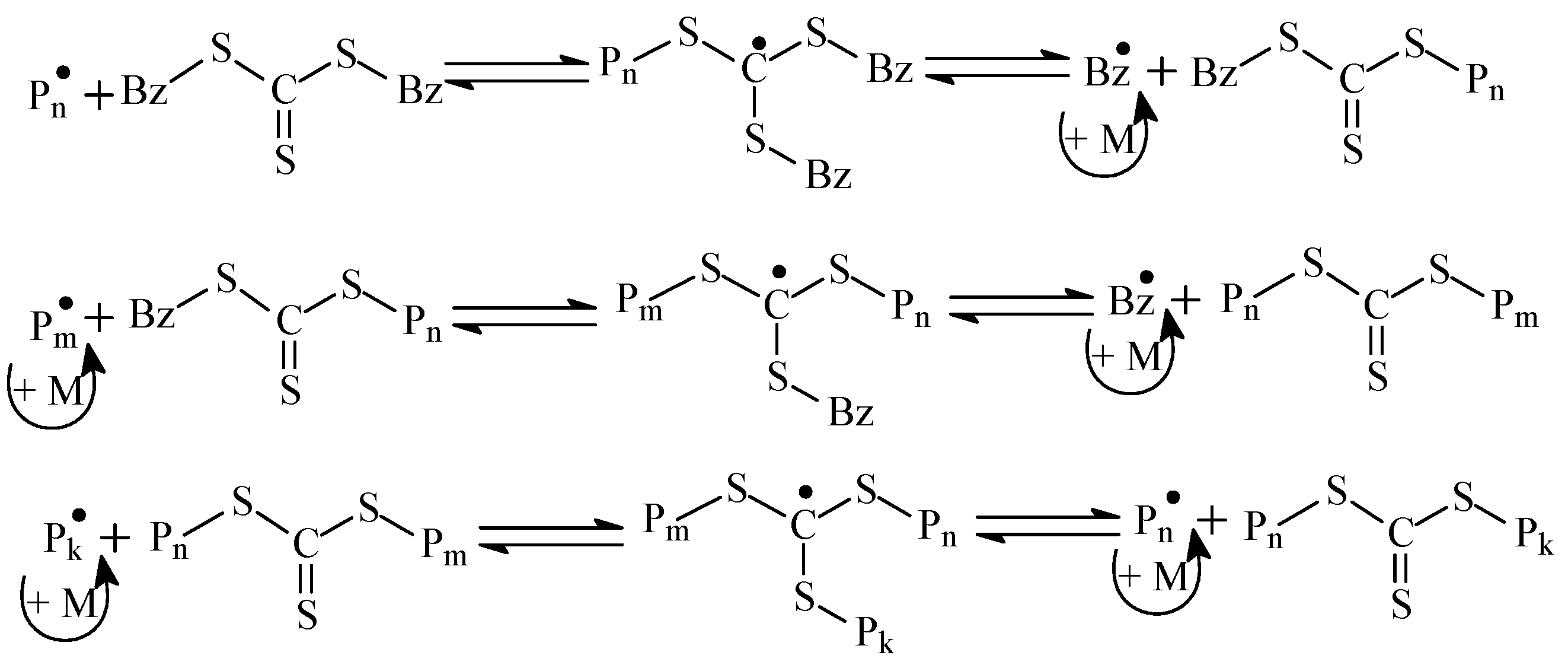
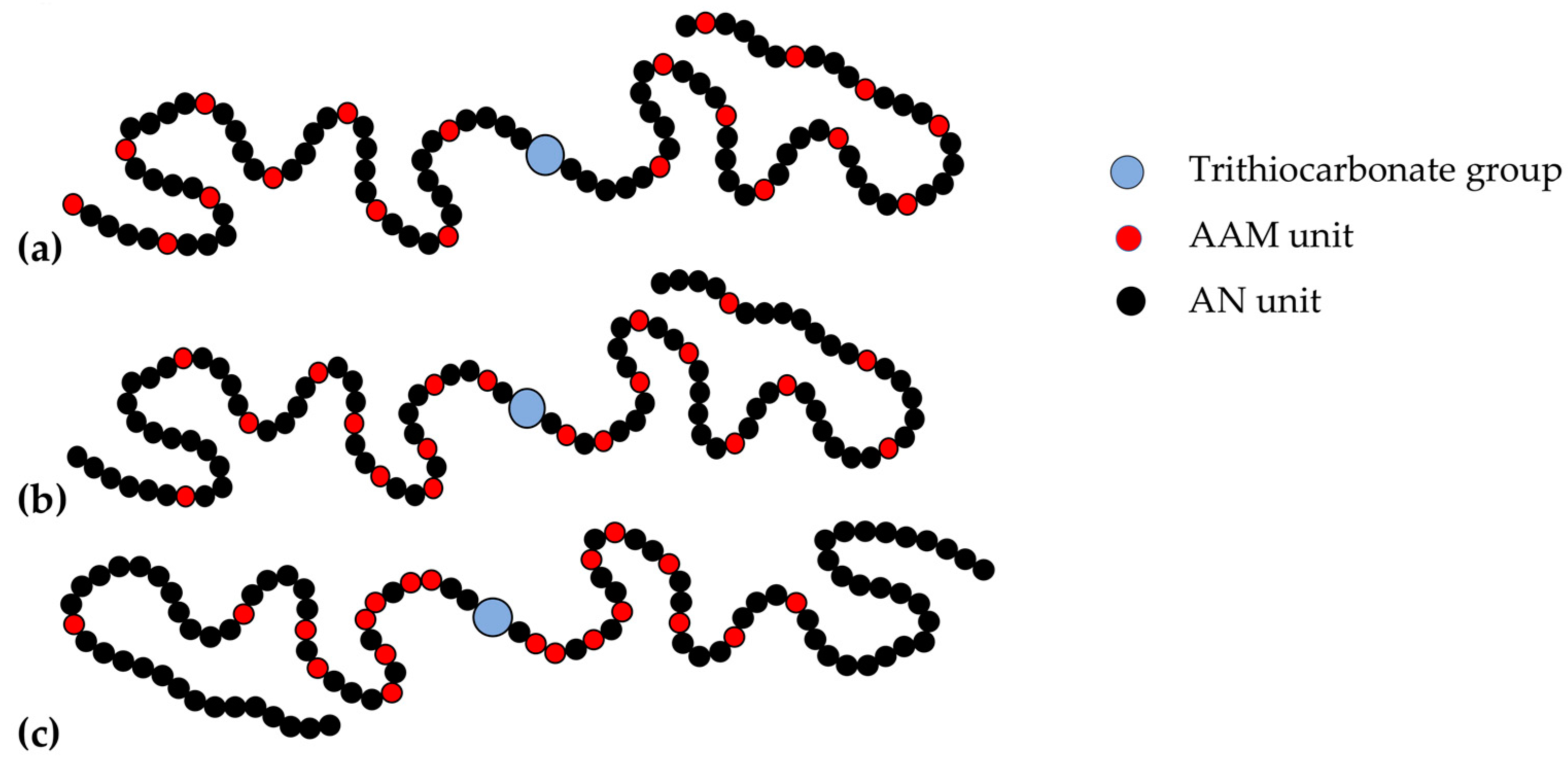
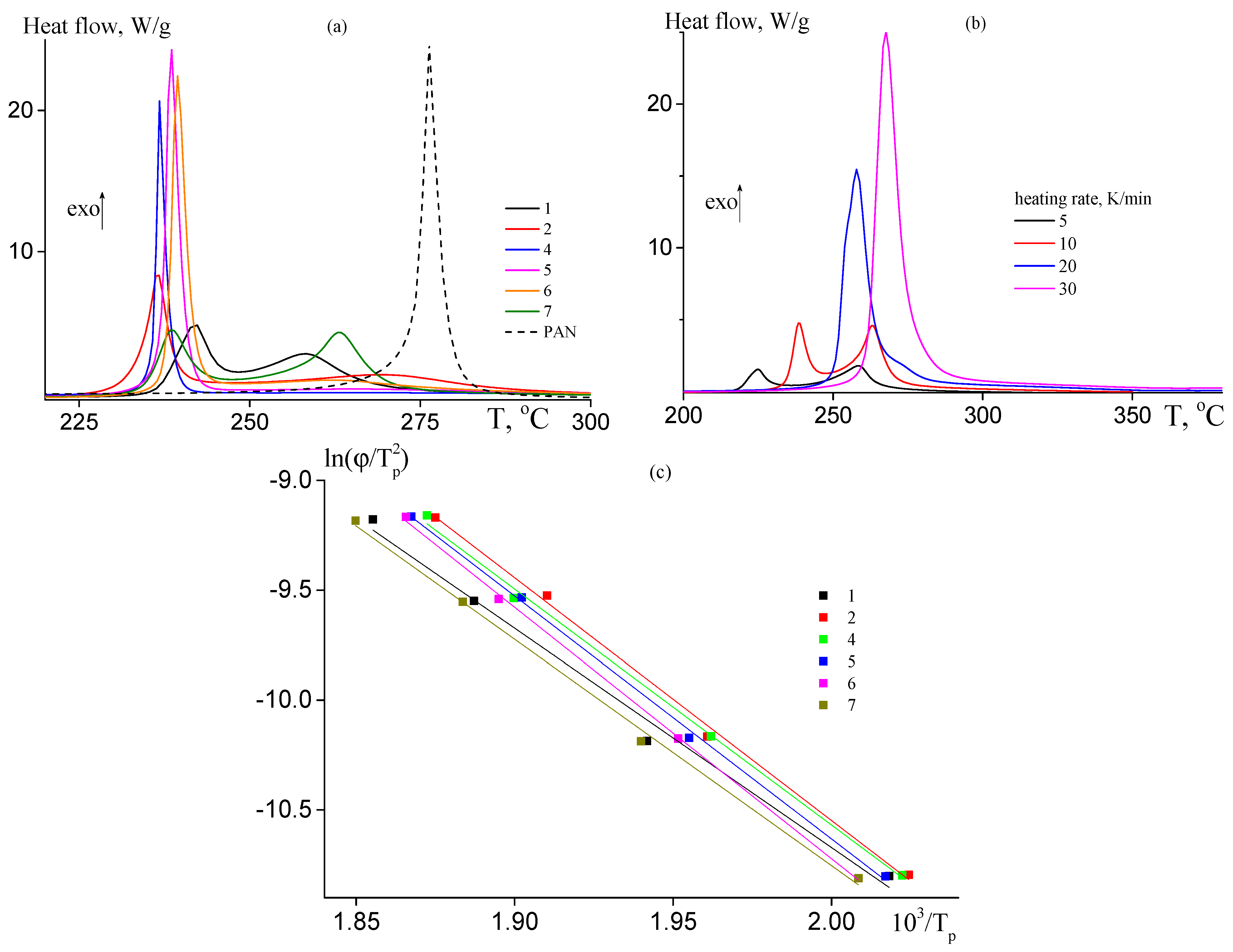
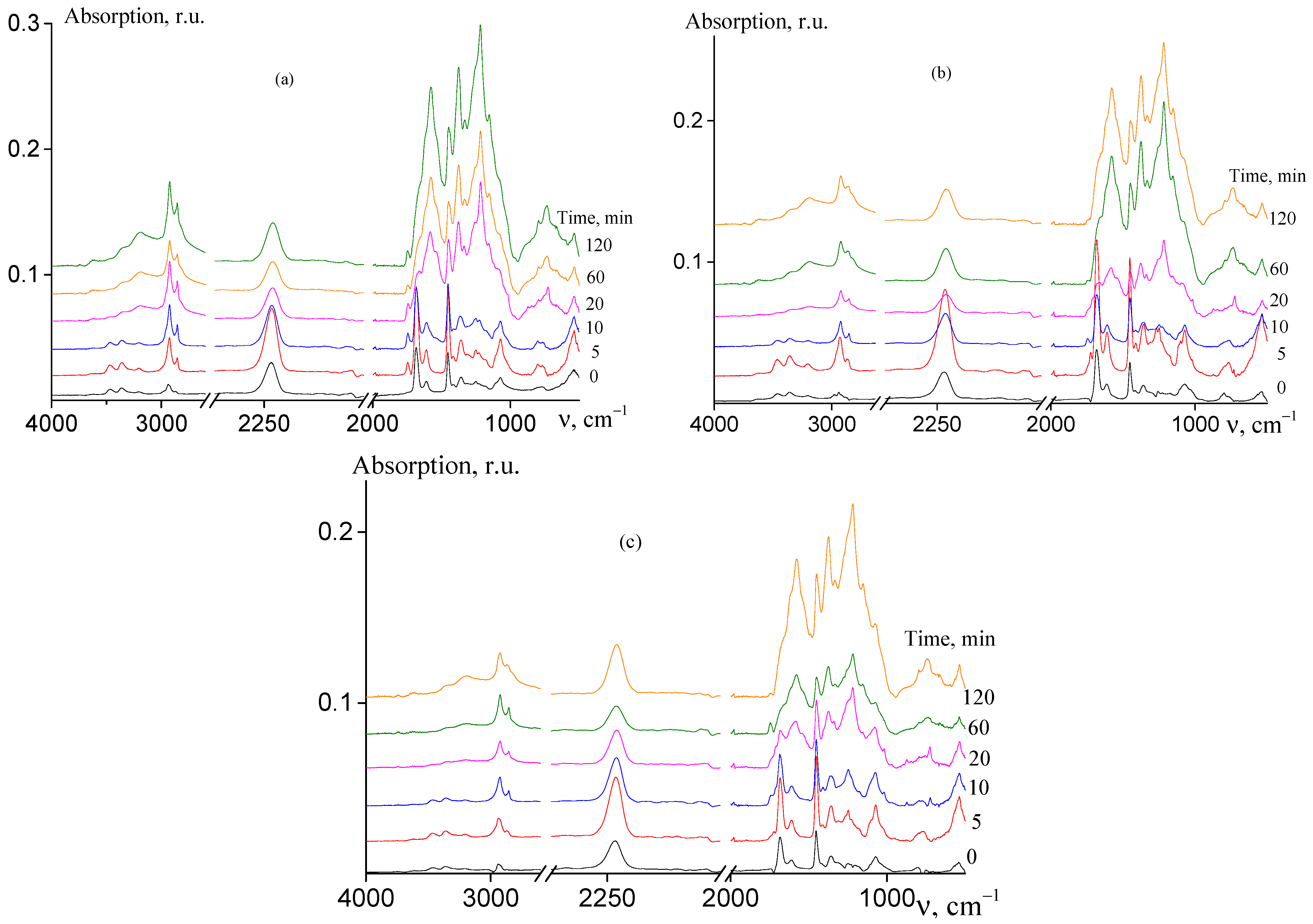
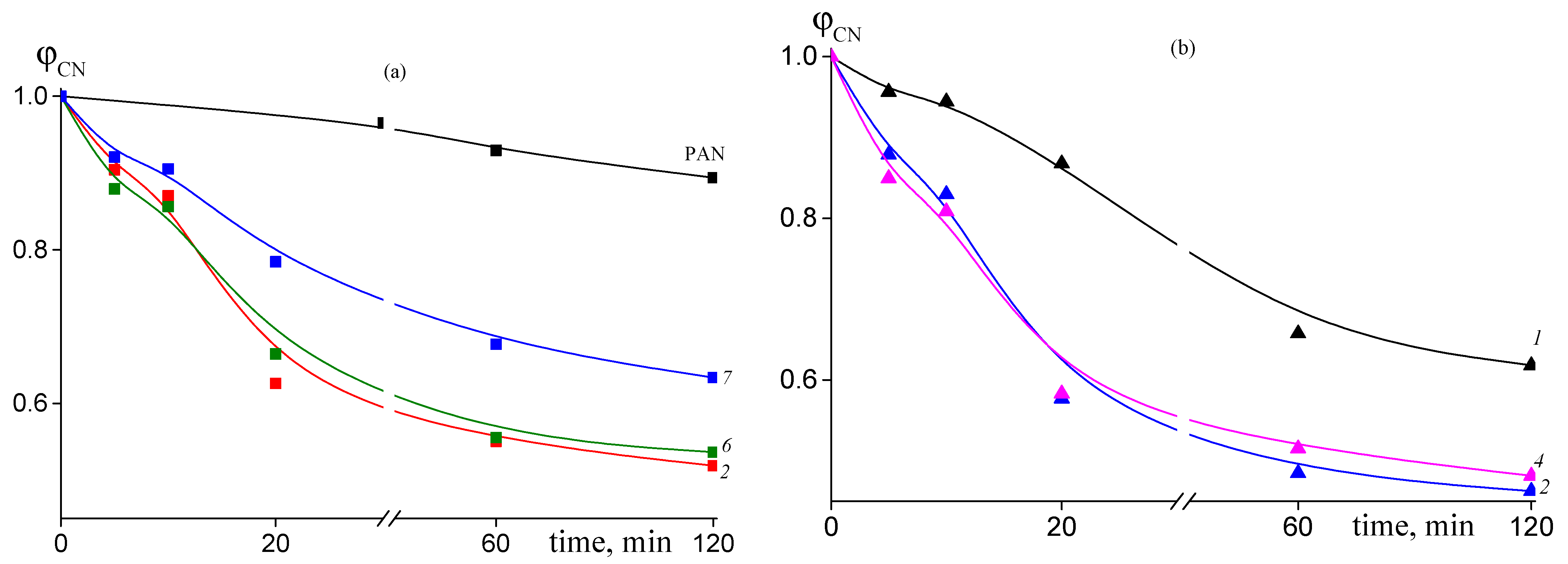

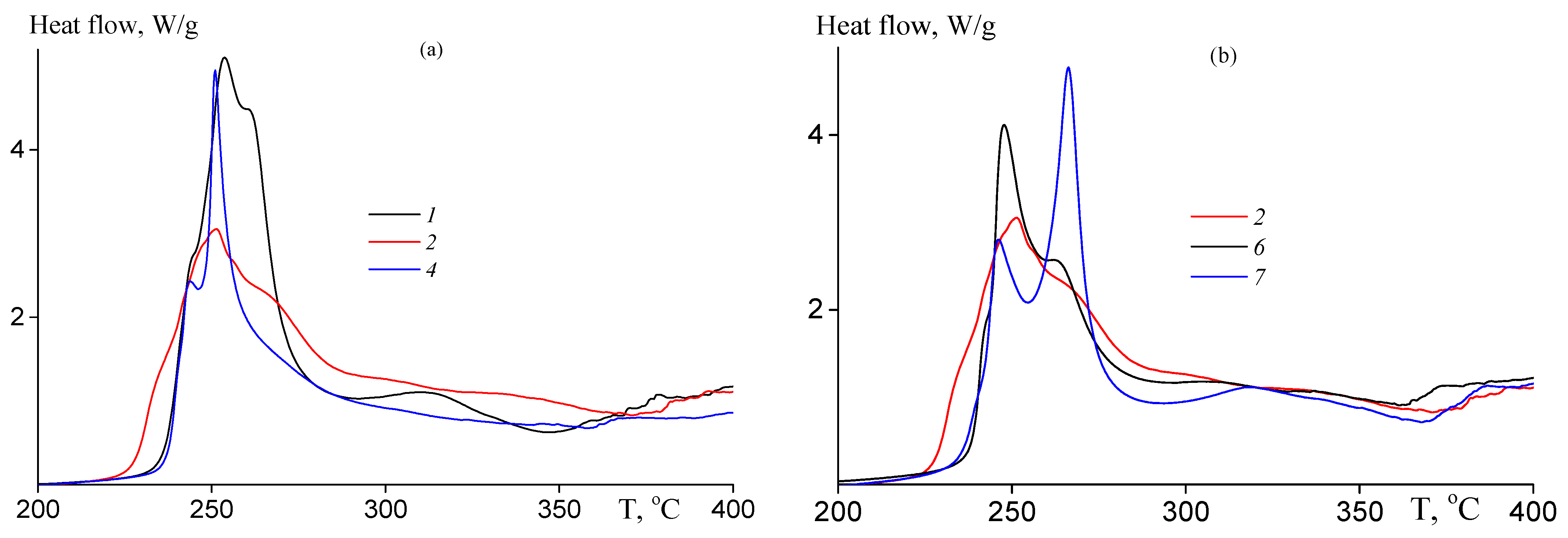
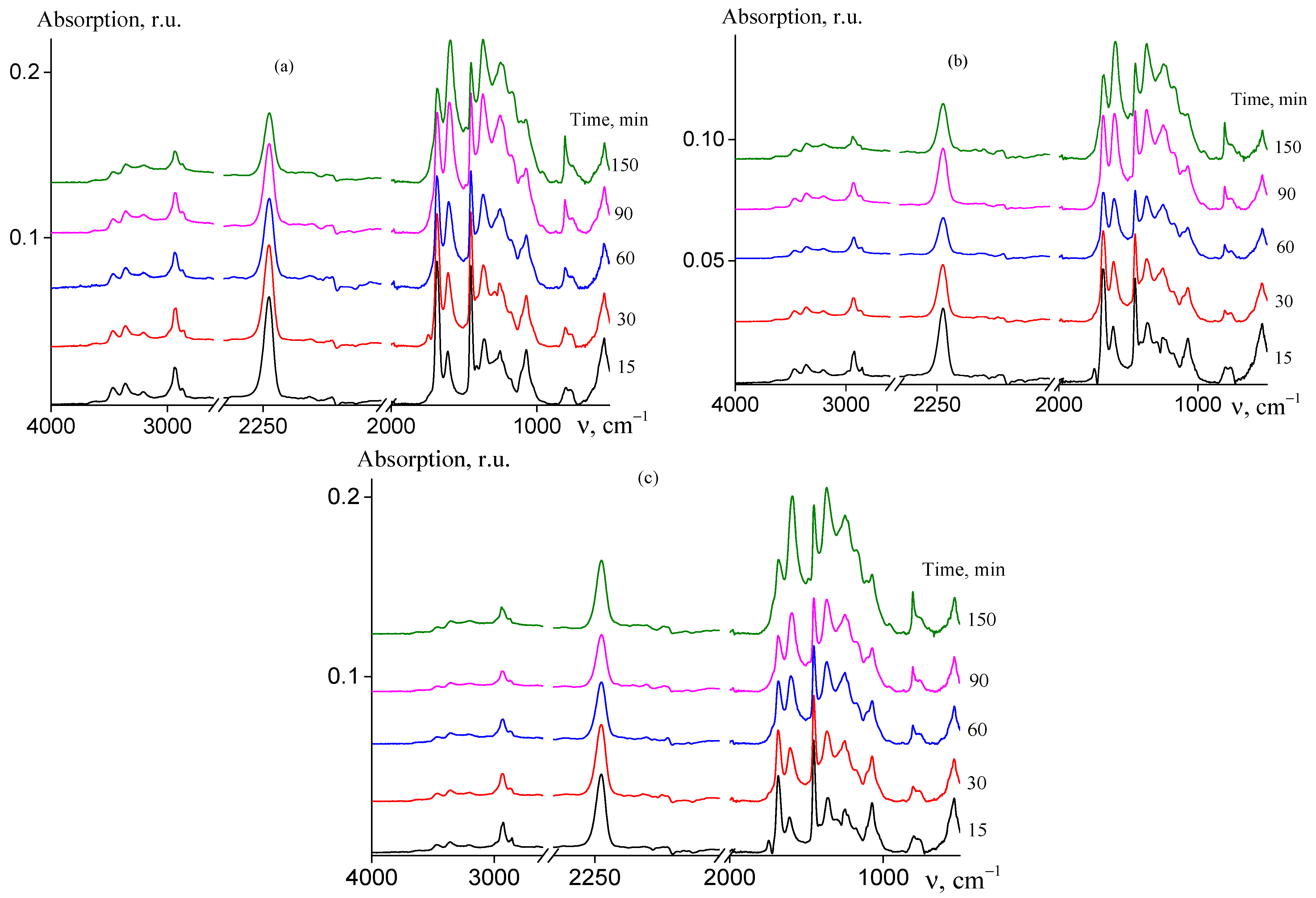
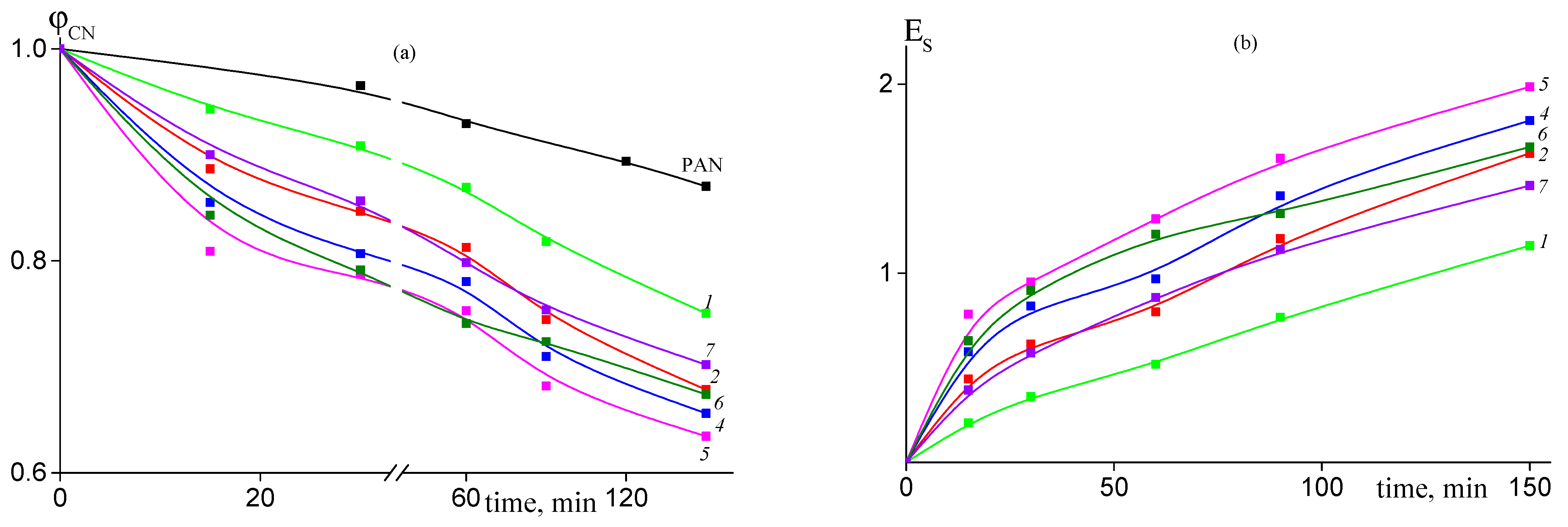

| Sample | Initial Monomer Feed, mol. % | Total fAAM Loaded in Reaction, mol. % | Process | Addition of AAM | |
|---|---|---|---|---|---|
| fAN | fAAM | ||||
| 1 * | 98 | 2 | 2 | Batch | Together with AN |
| 2 * | 95 | 5 | 5 | Batch | Together with AN |
| 3 * | 93 | 7 | 7 | Batch | Together with AN |
| 4 ** | 93 | 7 | 7 | Batch | Together with AN |
| 5 ** | 100 | — | 15.2 | Continuous | AAM/DMSO mixture (1/1 wt) was introduced with the rate of 4 mL/h during 2 h from the reaction onset |
| 6 ** | 100 | — | 10 | Continuous | AAM/DMSO mixture (1/1 wt) was introduced with the rate of 2 mL/h during 2.5 h from the reaction onset |
| 7 ** | 100 | — | 10 | Semi- continuous | AAM/DMSO mixture (1/1 wt) was introduced after 0.5 h from the reaction onset with the rate of 2 mL/h during 2.5 h |
| fAAM, mol. % | FAN-AN-AN, mol. % | FAN-AN-AAM = FAAM-AN-AN, mol. % | FAAM-AN-AAM, mol. % | FAN-AAM-AN, mol. % | FAAM-AAM-AN = FAN-AAM-AAM, mol. % | FAAM-AAM-AAM, mol. % | <NAN>n | <NAAM>n |
|---|---|---|---|---|---|---|---|---|
| 7 5 2 | 40.2 42.8 47.0 | 9.3 6.9 2.96 | 0.5 0.3 0.04 | 37.9 41.0 46.2 | 11.3 8.5 3.7 | 0.8 0.5 0.1 | 9.6 13.3 32.8 | 1.1 1.1 1.0 |
| Sample | fAAMtotal, mol. % | FAAM, mol. % | FAN-AN-AN, mol. % | FAN-AN-AAM = FAAM-AN-AN, mol. % | FAAM-AN-AAM, mol. % | FAN-AAM-AN, mol. % | FAAM-AAM-AN = FAN-AAM-AAM, mol. % | FAAM-AAM-AAM, mol. % |
|---|---|---|---|---|---|---|---|---|
| 4 | 7.0 | 8.8 | 79.4 | 7.1 | 3.5 | 3.5 | 5.5 | 0.8 |
| 5 | 15.2 | 10.2 | 78.1 | 7.0 | 3.9 | 3.9 | 6.2 | 0.8 |
| 6 | 10.0 | 9.2 | 83.3 | 5.8 | 2.5 | 2.5 | 5.0 | 0.8 |
| 7 | 10.0 | 6.0 | 89.3 | 3.6 | 1.8 | 1.8 | 0.9 | 0.8 |
| Sample | FAAM, mol. % | AAM Distribution | Tp, °C * | Heat Flow at Tp, J·g−1 * | −ΔH, J·g−1 * | Ea, k J·mol−1 |
|---|---|---|---|---|---|---|
| PAN | 0 | - | 276 | 25 | 493 | 113 ± 8 |
| 1 | 3.4 | Random | 242, 258 | 4.8, 2.8 | 460 | 83 ± 5 |
| 2 | 7.8 | Random | 236, 269 | 8.3, 1.3 | 638 | 92 ± 3 |
| 4 | 8.8 | Random | 236 | 20.7 | 429 | 89 ± 3 |
| 5 | 10.2 | Gradient | 238 | 24.3 | 609 | 92 ± 2 |
| 6 | 9.2 | Gradient | 239, 262 | 22.4, 0.9 | 662 | 95 ± 2 |
| 7 | 6.0 | Block-gradient | 239, 263 | 4.4, 4.3 | 656 | 86 ± 3 |
| Sample | FAAM, mol. % | Ton-set, °C | Tp, °C | –ΔH, J·g−1 |
|---|---|---|---|---|
| 1 | 3.4 | 236 | 243, 254, 262, 311 | 895 |
| 2 | 7.8 | 228 | 233, 251, 266, 302, 366 | 855 |
| 4 | 8.8 | 236 | 244, 251 | 720 |
| 5 | 10.2 | 236 | 242, 254, 267, 308, 340 | 740 |
| 6 | 9.2 | 238 | 241, 248, 264, 315, 340 | 770 |
| 7 | 6.0 | 238 | 240, 246, 266, 330 | 920 |
Disclaimer/Publisher’s Note: The statements, opinions and data contained in all publications are solely those of the individual author(s) and contributor(s) and not of MDPI and/or the editor(s). MDPI and/or the editor(s) disclaim responsibility for any injury to people or property resulting from any ideas, methods, instructions or products referred to in the content. |
© 2023 by the authors. Licensee MDPI, Basel, Switzerland. This article is an open access article distributed under the terms and conditions of the Creative Commons Attribution (CC BY) license (https://creativecommons.org/licenses/by/4.0/).
Share and Cite
Toms, R.V.; Balashov, M.S.; Gervald, A.Y.; Prokopov, N.I.; Plutalova, A.V.; Chernikova, E.V. Influence of Monomer Sequence on the Cyclization Behavior of Poly(acrylonitrile-co-acrylamide). Appl. Sci. 2023, 13, 3734. https://doi.org/10.3390/app13063734
Toms RV, Balashov MS, Gervald AY, Prokopov NI, Plutalova AV, Chernikova EV. Influence of Monomer Sequence on the Cyclization Behavior of Poly(acrylonitrile-co-acrylamide). Applied Sciences. 2023; 13(6):3734. https://doi.org/10.3390/app13063734
Chicago/Turabian StyleToms, Roman V., Mikhail S. Balashov, Alexander Yu. Gervald, Nikolay I. Prokopov, Anna V. Plutalova, and Elena V. Chernikova. 2023. "Influence of Monomer Sequence on the Cyclization Behavior of Poly(acrylonitrile-co-acrylamide)" Applied Sciences 13, no. 6: 3734. https://doi.org/10.3390/app13063734
APA StyleToms, R. V., Balashov, M. S., Gervald, A. Y., Prokopov, N. I., Plutalova, A. V., & Chernikova, E. V. (2023). Influence of Monomer Sequence on the Cyclization Behavior of Poly(acrylonitrile-co-acrylamide). Applied Sciences, 13(6), 3734. https://doi.org/10.3390/app13063734











